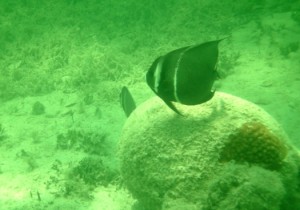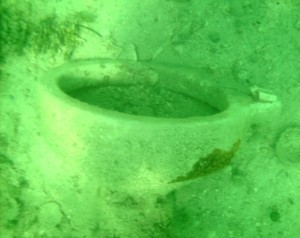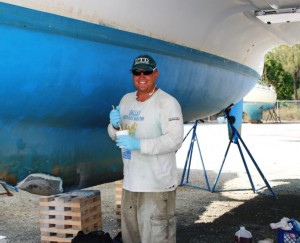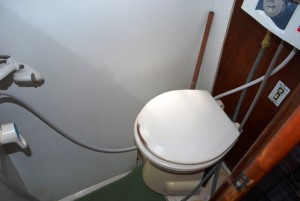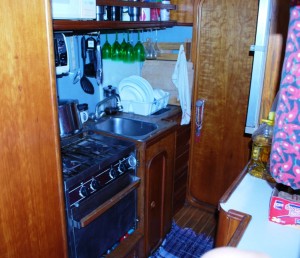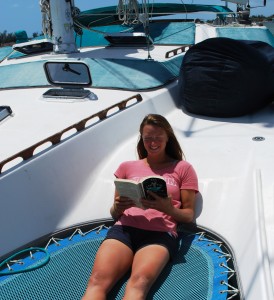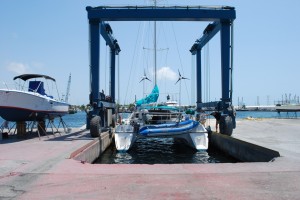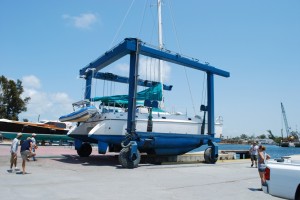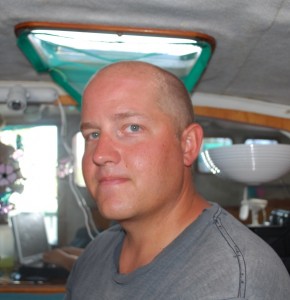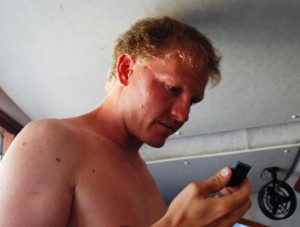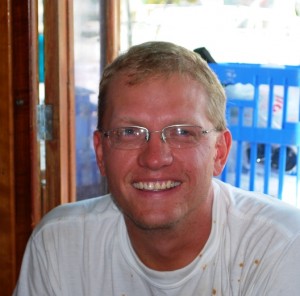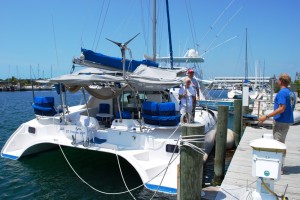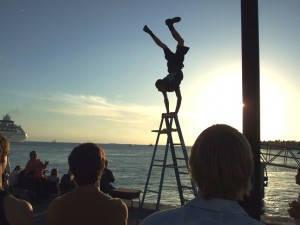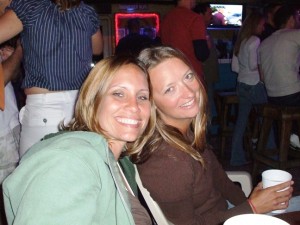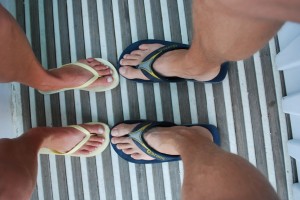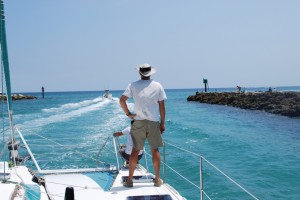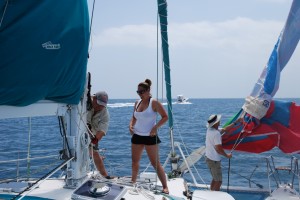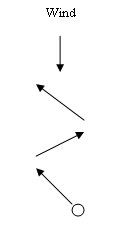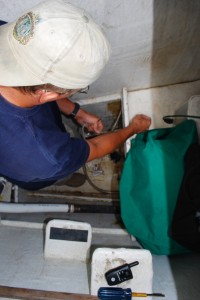We’re currently under the impression that we’ll be able to shove off tomorrow (Wednesday). Here’s how the saga of the shaft alignment problem has gone over the last week or so:
Friday (4/10): Found that there was an alignment problem that was likely a bent shaft.
Monday (4/13): Mechanic confirmed that there was an issue aft of the engine/transmission so we hauled the boat out, dropped the rudder, pulled the shaft, and took it to the mechanic to take to the machine shop.
Tuesday (4/14): The mechanic brought the machined shaft & coupling by on his way home from work, but we’d already found an issue with some glass work on the starboard keel, so we wouldn’t be ready to splash until Thursday.
Thursday (4/16): We re-installed the shaft and could have gotten back in the water, but the travel-lift at the yard broke and parts wouldn’t be available until Friday morning.
Friday (4/17): Splashed the boat around noon and called the marina where the mechanic has his shop, but they didn’t have a place for us to tie up; we have to wait through the weekend.
Monday (4/20): The marina still didn’t have a free spot to tie up, so we had to wait until Tuesday.
Tuesday (4/21): A spot on the fuel dock finally opened up and we were there before noon. The mechanic came by, but wasn’t able to align the shaft to the engine. At this point, they suspect the issue is the metal spacer between the shaft coupling and the engine transmission as the mounts seem to be OK and the shaft aligns properly to the transmission without it present. We’ll replace it with a drive-line saver, a sacrificial nylon spacer that isn’t as demanding in terms of alignment and will protect the transmission from damage in the event we get the prop shaft fouled with a line in the water. Unfortunately, the drive-line saver is damaging to the wallet and the mechanic/dealer didn’t have one in stock. It should be here by 10am tomorrow and if things work with it installed, we’ll be ready to go. If things don’t work, we’re going to be in for some more time in sunny Key West.
Since we’re tied up at the fuel dock, we’ve spent the day filling water and fuel tanks & jugs, spraying down the boat, making final repairs, defrosting the fridge/freezer and reducing its space to conserve DC, and stowing gear in preparation for our passage south. This is our first real diesel fill-up so we aren’t sure exactly how we’re doing on fuel economy, but it’s looking like about half a gallon an hour, which is about what we expected. With 50 gallons in each fuel tank and several jerry jugs, we should be able to motor quite a ways if needed, especially if we conserve fuel by running only one engine at a time.
Pura Vida has quite a bit of storage area, including lots of space in the bows. We’d tried to use the bows to stow only light items, but in spite of our attempts, the bows were a little low on their waterlines. Also, they seemed to bury too easily when heading into the waves close-hauled, and we were pitching or hobby-horsing more than we’d expected. Because we’re living in the forward cabins, we moved most of the stuff in the bows back into the aft cabins. The bows are definitely riding higher now and we’re hoping we’ll have a more sea-kindly motion as a result.
We have to give a shout-out to several of our friends who’ve provided hard drives with more music than we can possibly listen to. It has come in very handy. Our favorite approach is to copy songs onto a Flash drive and then use the flash drive in our stereo. My friend Kopan also sent us a hard drive of movies, which has made for great entertainment in the evenings while we’re at anchor waiting for repairs to be completed here in Key West.
Speaking of generous gifts, here are a couple of pictures from the underwater camera that we got as a gift at our wedding shower. The wind died down a little yesterday, which made things warmer on the boat and improved the visibility in the water where we’re anchored. Lauren took advantage of the clearer water to take a break from the heat and do some snorkeling around the boat. We wanted to get an anchor pic, but the Rocna completely buried itself in the sand. She did see a few fish and a discarded marine head.
For those of you keeping up with the various equipment issues, here’s a brief update. The autopilot did really well from Boca Raton down to Key West, including doing a good job of “auto-learning” our boat characteristics while headed into 3-4 foot seas. The one exception was that when sailing downwind, the autopilot couldn’t correctly keep track of the rudder orientation. It would eventually accumulate so much error in the assumed rudder position that it believed the rudder was hard over even though it wasn’t and would stop trying to turn the rudder anymore. It was easy enough to reset the autopilot, but annoying to keep an eye on it, so we installed the “optional” rudder reference and that should finish up the autopilot for the most part.
The problems with the electric starboard head (that’s the dumper, Casey & congrats on your engagement) turned out to be an old joker valve on the discharge. We replaced the joker valve and the bowl no longer back-fills. The somewhat weak discharge pump seems to have been partly due to the semi-clogged discharge elbow that houses the joker valve. It’s up and running like a champ, which has made things a little more pleasant in the port hull.
We haven’t had the battery capacity we’d expected after replacing the house batteries in Ft. Pierce. In fact, we’d had about half the expected capacity. We checked the battery connections, water levels, etc. and found that I’d missed tightening up the nut on one connection, so we’re now expecting to double our battery capacity. We have four Deka GC15’s, which should give us about 430 Ah (due to charge/discharge characteristics, it’s only reasonable to use about a third of the capacity, but we still should be able to go at least a couple days with little battery charging). We haven’t done too badly, even without all our battery capacity, as we so far haven’t had to run the engines just to charge the batteries. We’ve either had plenty of wind for the wind generators stopped at a marina, or had to run the engines anyway to get in or out of an anchorage.
Yesterday I installed the ICOM AIS receiver that had been back-ordered. We’ve hung around long enough that it finally came in, and Dad was able to send it to us. We’d purchased a radar, but the radome didn’t fit due to the jumpers on the forward portion of our mast. Because we’re not planning to sail in areas where fog is a frequent problem, we sold the radome and elected to get an AIS instead. AIS transmitters are mandatory on all large international ships, and we’re planning to use our receiver like a poor man’s radar. The AIS uses VHF frequencies to broadcast a vessel’s name, location, speed, heading, destination, etc. and is used primarily for collision avoidance. When you’re sailing near or crossing shipping lanes, especially at night, it can be difficult to tell exactly how far away a ship is or what its course may be. The AIS should be pretty handy in helping us identify and avoid shipping traffic, as all vessels with AIS transmitters now show up as targets on our chart-plotter.
We’ve made numerous other small repairs on a daily basis, and it does seem like we’re making a bit of progress in terms of functionality on the boat as well as settling into boat life.
We are back on the water, so I am once again inspired to blog. Not that being “on the hard” was so bad. It definitely had its perks. For example, we enjoyed some delicious Chinese food that Dallas and Wes’ thoughtful brother, Tim, had delivered to us (thanks, Tim!). We took advantage of the boatyard facilities that were actually plumbed with city water, unlike the showers at “Fort Prison” that, with their rotton-egg-smelling water and lack of shower curtains or tiled floors created conditions in which even Tiffany and I took short showers. We also met some interesting people, including three Germans with whom we had some (mis)adventure when the captain fell down the companionway stairs on their Morgan monohull. (We helped them to navigate the American medical system (i.e., ambulance, E.R.) which, incidentally, they found to be “immer langsam” (always slow) and incredibly expensive. On the other hand, they weren’t too thrilled about paying half of their income to the German government to cover the cost of nationalized healthcare.) Finally, we were able to complete repairs such as the fiberglass patch on the keel using the trusty folding bikes to obtain necessary supplies.
Less delightful is adapting to the heads–in this case I am referring to the toilets specifically. Marine heads are unique in that they are easily clogged, so in general, sailors make it a policy not to place any toilet paper in them. On Pura Vida, we have two heads (we decided that this was essential for two couples), a manual and an electric. The latter works much like a typical toilet in that there is a button that is depressed to flush it. The difference is that the waste is then pumped to a holding tank, which, in our case, has resulted in the head becoming somewhat “odiferous” (per Dallas). The manual head is less problematic in that it discharges into the ocean. However, according to Coast Guard regulations, this can only be used when one is at least three miles offshore, so in the meantime, we need to address the source of the unpleasantry on the electric side. This is Dallas’ unfortunate project of the day.
Monday we head back to the marina for a quick alignment of the port engine, and then it’s back offshore! Since we are so far behind schedule, we are considering making a run directly to Panama with the option of stopping in Mexico if necessary to rest or resupply. Once offshore, I am sure that I will be reminded of some of the primary benefits of the cruising life, including freedom of mobility, the tranquility of isolation, and the pleasure of self-sufficiency. While not for everyone, it certainly has its merits.
Our 21’ beam makes it hard to find a yard with a travel-lift big enough to haul us, but as luck would have it there was one within sight. We just motored out of the channel at Oceanside, made a U-turn, and headed into the channel for the Old Island Boatyard. The travel-lift there is 21.5’ and we used almost all of it. We weren’t quite as nimble using only one engine, but the guys on the dock gave us a hand and we were in the slings in no time.
Wes and I worked for about an hour to disconnect the steering quadrant from the rudder so it could be dropped. We ran into more of the same – stainless bolts running through aluminum that have set for years in the marine environment. The result is lots of galvanic corrosion that seized the bolts. Luckily, there we didn’t have to try to use the propane torch in the small space; plenty of PB Blaster, the breaker bar, and lots of elbow grease were enough to get all the required bolts moving again. Tiff had a close call when the rudder finally came loose. We didn’t realize it would drop so suddenly once the last of the steering quadrant was disentangled or that it was quite so heavy (the rudder shaft alone is about 6’ of solid stainless 2-3” in diameter. She was below helping to steady the rudder as we dropped it and got a bit of a surprise when it finally dropped. Luckily, other than a pair of broken sunglasses and a little soreness when she winks, she’s unscathed. Once we’d dropped the rudder, the guys in the yard lifted the boat in the slings nearly as high as it would go until the top of the rudder shaft cleared the bottom of the hull and we were able to move the rudder out of the way and allow the boat to be moved to a semi-permanent spot on the hard. We were fortunate that it was a slow day in the yard and we had plenty of time to sit and work in the slings.
While we were out of the water we also make the unfortunate discovery that the keel repair we’d had done in St. Marys in January hadn’t stuck. We re-drilled the stop in the starboard keel and got a little bit of moisture out of it. Wes re-worked it yesterday and we’re hoping that this time it will last longer.
While we weren’t moving, we took the opportunity to try to do some much needed haircutting. We’d purchased clippers before we left with the intent of doing our own haircuts. Unfortunately, the clippers that had been recommended to Lauren were actually trimmers and were completely overwhelmed by the task of cutting a full head of hair. After several attempts, Wes was left with a patchy half-head of hair that was a sight to see. A new set of clippers cleared up the problems, tough, and Wes and I were both able to get a proper haircut. Mine haircut was the first time Lauren had ever cut hair and she must have had beginner’s luck. She did an impressive job.
We arrived in Key West Wednesday morning after a good sail over from Largo in N & NW winds. We hadn’t spent the night in a marina since we were in Ft. Pierce, so we decided to spend the first night at the Key West Bight city marina to make it easier to do a couple repairs that needed power tools and make sure everyone could get a nice shower. We’ve all been to Key West before, both by sail and by car, but it is still a fun stop. Mallory Dock at sunset and Duval Street haven’t slowed down a bit, and there’s still a pretty good talent level in the numerous live bands that play for no cover in the nightlife district. Dante’s is also a great stop as they have a large pool by the Bight docks that’s open to pretty much anyone.
The island proclaimed itself the Conch Republic in 1982 as part of a somewhat tongue-in-cheek secession protest due to a Border Patrol blockade and checkpoint on US Highway 1. The highway is the only road in and out of the Keys and the blockade resulted in a significant inconvenience for the residents and a decrease in tourisim. The Conch Republic celebrates Independence Day on April 23 and has the slogan “We seceded where others failed.”
The major repairs on the list for this stop were installing a rudder reference for the autopilot (it’s supposed to be optional with this model and the autopilot did pretty well on every point of sail except downwind, where it seemed to lose track of the rudder position, so this should be an improvement), having a couple sails repaired (we mentioned the spinnaker in the last blog but we also lost some stitching and chafed the jib on the spreaders on the way here), installing an anchor chain stop to hold the anchor & chain while underway, fixing our dim anchor light, and doing the 50-hour oil change on our newly rebuilt engines.
The first several repairs went smoothly. We got the rudder reference and chain stopper installed on the same day we tied up and handed the sails off for repair the 2nd day. Unfortunately, while doing the engine oils changes I noticed that the port engine, which had been vibrating more than even a small diesel should, was out of alignment with the prop shaft. It’s something we’d suspected before leaving Amelia Island, but our mechanic didn’t have time to make it over to check things out before we left. Aligning the shaft to the engine transmission is a little tricky and it’s one of the repairs that I’ve left to a mechanic in the past, but I gave it a shot on my own this time. It looks like we might actually have a bent shaft or an issue with the shaft coupling, so we’re headed into a marina tomorrow to have a mechanic take a look. Worst-case, we may have to be hauled out this week to have the port prop shaft replaced. We’ll keep you posted on that one. There’s no end to the fun :)
In terms of places to be held up for a bit, Key West isn’t too bad. The anchorage is nice and of course free (though use of the dinghy dock is $6/day and use of the showers is $20/week — I know, it’s not exactly rent in LA). Wes just checked the weather for the next 4-5 days and every day is the same — partly cloudy with a high of 83 and a low of 74. Not bad.
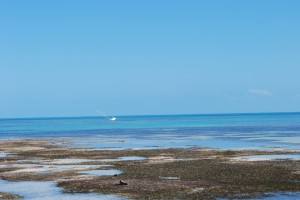
We’re all starting to do a bit of reading as well. Tiff’s been reading a novel, Wes started the cruising guide for the South Pacific, Lauren has started Zen and the Art of Motorcycle Maintenance (a great read, for those of you who haven’t read it yet), and I’m about halfway through a book on the history of circumnavigators. The stories of the early ocean crossings and circumnavigations are truly amazing. Without accurate charts (in some cases no charts at all), no accurate way to find longitude, no knowledge of how to prevent scurvy, and small wooden ships, it’s no wonder that most of the early circumnavigations involved quelling a mutiny at some point, loss of most of the ships in the small fleet, and significant loss of crew due to death & desertion. The author concludes that the day of circumnavigators is over in that the challenge and commercial utility of circumnavigation is essentially gone. This is definitely true for something on the level of a commercial or state-sponsored venture, but it’s still not a trivial undertaking for the small boat sailor.
On the walk back to the dinghy last night, Lauren and I spied a cardboard box with several pairs of flip-flops in it at the edge of the dock. A passing local informed us that tourists often leave items on the day-charter boats and never retrieve them, so they’re just left on the dock. As I’d had my flip-flops eaten by a dog in Amelia Island and Lauren had just lost one of hers overboard a couple of days ago, we tried them on and both found a great pair with a perfect fit and already broken in!
It has been an eventful few days. We said good-bye to Tiffany’s parents on Saturday morning and headed out the Boca Raton Inlet. There were many recreational boaters and some shallow shoals to contend with, but soon we were out of the channel. The winds were from the north (they are typically from the south this time of year—the same direction that we are trying to head), so we thought we might be able to cover some ground early on using our nice spinnaker.
We settled for using the mainsail and genoa and headed offshore. The seas were not too intense, but having been on land for a few weeks, the motion was enough to make us all a little queasy. Moreover, the southerly current pushing against us from the Gulf Stream was amazingly strong. Wes kept track of our average speed early on in his watch and informed us that at the rate we were going (around 0.5 knots per hour), we would reach Miami in a week or so! This was obviously frustrating, but we persisted at adjusting the sails to maximize our speed and ended up plugging along at two to three knots for the remainder of the day.
I took my first solo watch Saturday evening. I had requested my own so that I could experience the independence and freedom of it, and let’s just say that my expectations were met. I felt pretty confident at the helm after reading It’s Your Boat, Too by Suzanne Giesemann, a former Navy commander. As you might guess from the title, the thesis of her book is that women should take a more proactive, participatory role if they want to fully enjoy boating as their partners do. For me, this reinforced what we had already planned in terms of my role on Pura Vida, but I learned quite a bit from the section on the basics of sailing—navigation, communications, weather, boat handling and docking, etc. and felt that I was up for the challenge of taking the helm (with Dallas nearby of course).
Speaking of challenges, Suzanne posits in her book that women often are spectators on their boats because they are fearful of looking like they don’t know what they are doing. She points out that men start out as beginners, too, but their excitement about the challenge and adventure involved in boating overcomes their desire to save face. In my case, I have learned to love a good challenge, and moreover, to laugh at myself in the process. It’s a good thing, too, because I’ve been making a lot of mistakes! My first real mistake at the helm didn’t happen until midday on Sunday, when every man and his dog were fishing off the coast of Miami. Apparently I got too close to one of the small fishing boats for the captain’s liking, leading him to throw an empty can of beer in my direction. Oops!
By monitoring channel 16 on the VHF radio (as the Coast Guard requires), we learned that there were many utterances of “oops” (or perhaps another word) at sea on Sunday. There was a sailboat that hit a fishing boat pretty close to us such that we could hear the initial “may-day” call to the Coast Guard. There was also a woman who was very upset about her dog going overboard, but the Coast Guard put out an alert, and the dog was found soon after. Wes and Tiffany heard another distress call in which a sailboat was dismasted during a collision with a motor vessel and the two remained entangled waiting for the Coast Guard to arrive. The most serious alerts from the Coast Guard were about a 17 foot fishing boat that was overdue at its destination. We later learned that the boat had been found, but the man and child that had been on it had not. Needless to say, the Coast Guard was busy over the weekend, and we were reminded of how important it is to sail safely. In fact, I am pleased to report that Dallas is wearing his inflatable life jacket at the helm as we speak.
The only time that I felt nervous while at the helm (and woke Dallas up repeatedly) was on Sunday night when we were tacking through the shallow reefs at the top of the Florida Keys. For those of you who are not sailors, tacking is necessary when you are trying to go in the direction from which the wind is coming, because it is not possible to sail directly into the wind. Tacking involves sailing a zig-zag course in which you sail at an angle to the wind, switch directions, and sail from the opposite angle (see diagram below). Naturally, it is slower than sailing in a straight line, and when you also take into account the contrary current pushing us backwards, it no surprise that we fell short of our goal to arrive in Key West by Monday night. The good news, however, is that rather than sailing all night through the cold front with 20-30 knots of wind on the nose and 6-8 foot seas, we enjoyed an evening at anchor in Key Largo (and only got up once in the night to make sure the anchor wasn’t dragging!).
For the sailors out there, we have a 25kg Rocna anchor that we’e been very pleased with so far, as it’s always set the first time and held, but that wasn’t the case in Key Largo. Our first three attempts to set the anchor were in a grassy area near the entrance of the Key Largo channel that all resulted in the anchor filling with grass and soft sand and dragging along the bottom. After three unsuccessful attempts we considered trying our CQR, but decided instead to move to less grassy area where there were a number of other boats anchored. This time the anchor set on the first attempt and held as we swung with the backing winds from the front.
A good night’s sleep was just what the doctor ordered, and we woke up raring to get back out there. We decided to stay inside the reefs where the seas are calmer and there is less current. Initially, the seas created a condition of, as Dave on www.maxingout.com put it, “no-bruising cruising”. We took full advantage of it— Wes did some morning exercises while at the helm, Tiffany caught up on her reading, I cleaned and started blogging, and Dallas started in on his continual to-do list of repairs, only to discover 45 gallons of sea water in the forward port bilge! While this sounds like a serious problem, it took no more than a couple of hours for Wes and Dallas to empty the bilge and for Dallas, with the help of his tool-getting assistant (moi) standing by on the family-band radio, to reconnect the bilge pump hose that had become dislodged, plug up the hole from the broken holding tank vent through-hull, solder new bilge pump connections, and check to make sure the switch and pump were working.
Now the winds have picked up, and we are getting some violent motion created by the pounding of the bridgedeck of the boat against the waves as we beat into the wind (i.e., sail as close to the wind as possible). To me, it’s as if the boat is doing belly flops! However, there has been no “feeding the fish” on this, our second multi-day nearshore/offshore run. It seems that we are in fact getting our sea-legs.
Well, that’s all for now. Stay tuned for more about our adaptation to sea life, including taking showers using a bug-sprayer!


